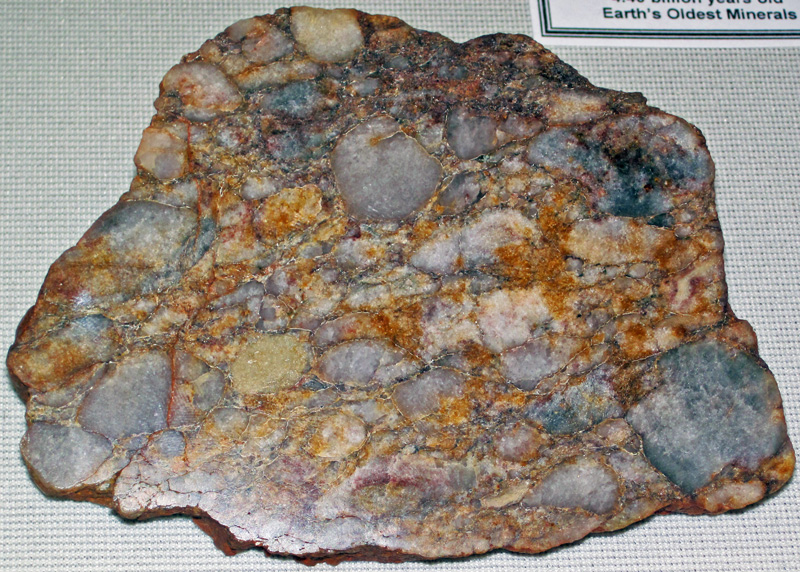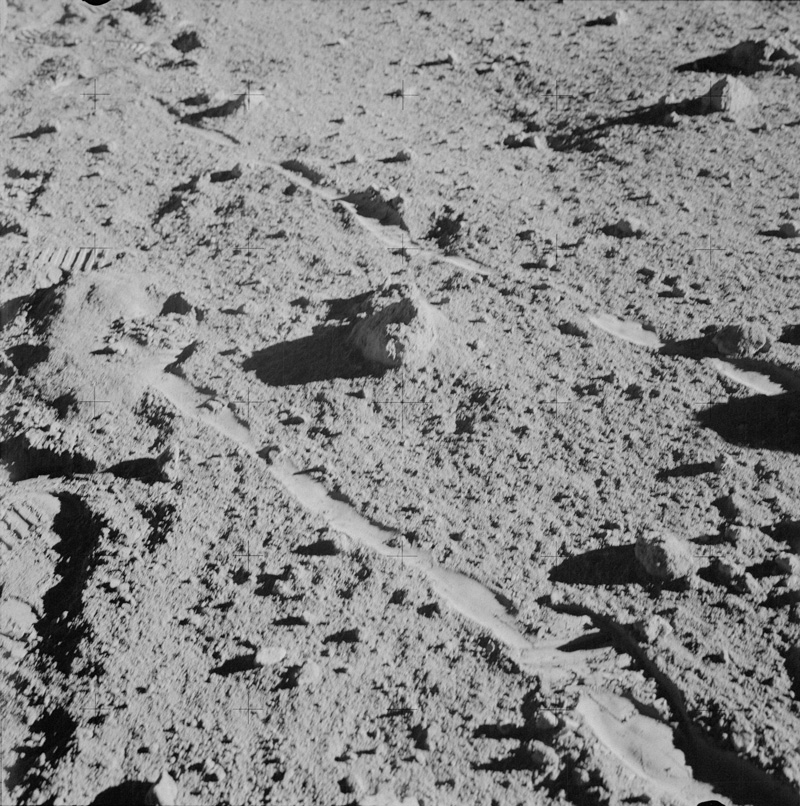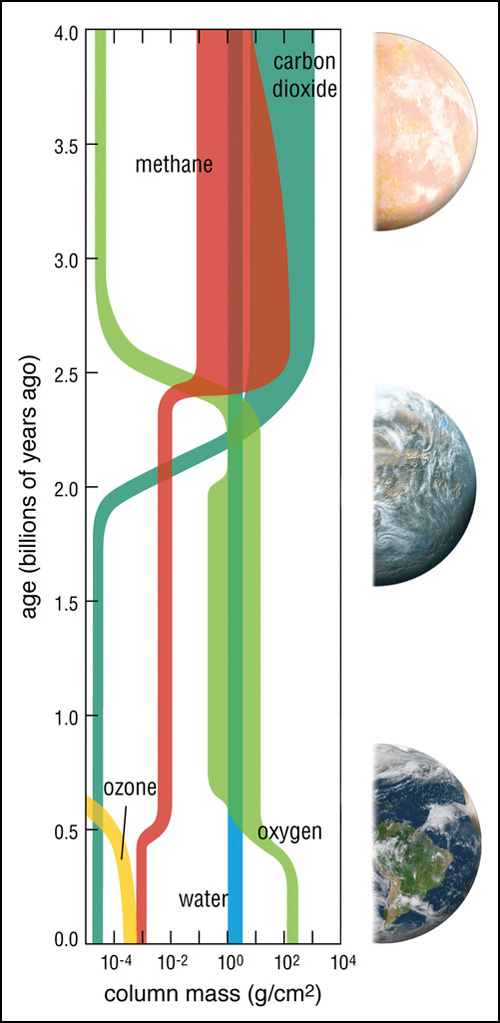When Earth was still in its infancy more than 4 billion years ago, it was surrounded by chaos. The planet had nearly been shattered by a giant collision whose debris would go on to form the Moon. The detritus of planet formation was still regularly colliding with the newly reformed Earth. Elsewhere in the solar system, the gas giants were amassing their own satellites and clearing out chunks of rocks that refused to fall in line. And for those first few hundred million years, the Sun was still waking up, with fusion by-products slowly building and causing its core to contract and glow brighter. By the end of the Hadean, when Earth was a meager half a billion years old, the Sun shone at about 75% of its current brightness.
That poses a problem. Not much is known about what was happening on Earth at that time, but what little we do know suggests that there was some amount of liquid water present at or near the surface starting in the Hadean, and there is evidence that life itself began in the Archean (4.0–2.5 billion years ago). If modern Earth were suddenly to receive 25% less sunlight today, it would quickly freeze over, so how did early Earth manage to avoid it for 2 billion years?
For decades this question, dubbed the “faint young Sun paradox” by Carl Sagan and George Mullen in 1972, has been an intriguing research topic for geochronologists, deep-time paleoclimatologists, and astronomers, although the scientists currently working to answer the question prefer to call it not a paradox but just a “regular ol’ problem.”
“It isn’t really a paradox in the way that we would normally understand it,” said Colin Johnstone, an astrophysicist at the University of Vienna in Austria. A paradox describes a contradictory statement or phenomenon, and because it is somewhat naive to assume that early Earth was anything at all like modern Earth, he said, an explanation for the faint young Sun problem might not contradict settled science or the geological record at all. “It’s more just something we don’t quite understand,” Johnstone explained, “and so the problem is, How is it that the Earth was not frozen given that the Sun was less bright in the past?”
“Early Earth basically was an exoplanet. It could have been just as alien as a rocky exoplanet might be to Earth today.”
Finding a noncontradictory answer “gets more and more difficult with every million years you go back,” said Georg Feulner, a deep-time paleoclimatologist at Potsdam Institute for Climate Impact Research in Germany. “The further back you go in time, all the uncertainties add up, and you just have to live with that. But still, I’m an optimist. By using an interdisciplinary approach, by understanding models better, by getting better isotope data, by understanding the space environment better, and by looking at the evolution of three of the four terrestrial planets in concert, I’m optimistic that we can narrow things down.”
Solving this problem will help determine the conditions that led to life springing up on Earth and could help identify other planetary harbors of life.
“Early Earth basically was an exoplanet,” said Claire Guimond, an exoplanet geoscientist at the University of Cambridge in the United Kingdom. “It could have been just as alien as a rocky exoplanet might be to Earth today—different atmospheric composition, different kinds of surface conditions, everything. A faint young star is always going to be something that a planet experiences. If you’re interested in a planet being temperate enough to harbor conditions for the origin of life, then you’re probably going to be interested in how likely it is that planets can overcome the lower luminosity.”
Fire: The Young Sun
At more than 4.5 billion years old, the Sun is just bright enough to maintain (current) Earth’s globally connected liquid ocean, and the Sun’s X-ray and ultraviolet (XUV) radiation and flares are weak enough not to strip away Earth’s protective atmosphere. But there is no way to look at the Sun today and know how bright it was or how intense its XUV radiation was during the Hadean or how it evolved to its present state. So where does that knowledge come from?
To understand the young Sun, astronomers look for clusters of stars in the galaxy whose members were all born at the same time, a circumstance that allows researchers to calculate the stars’ age. If the cluster has stars that are of the same mass as the Sun, those stars can serve as snapshots of the Sun’s history. From this approach we know that newborn Sun-like stars shine at about 70% of the Sun’s current brightness and gradually get brighter throughout their lives. At 500 million years old (equivalent to the end of the Hadean), they reach roughly the 75% mark. With enough solar analogues of different ages to anchor solar evolution models, stellar astronomers have put together a fairly thorough timeline tracking the evolution of the Sun’s brightness, size, and mass.
Our knowledge of the Sun’s rotation speed, XUV radiation, activity level, and solar wind history remains incomplete.
However, sometimes solar analogues behave differently from each other and offer a range of possibilities for our Sun’s history. Our knowledge of the Sun’s rotation speed, XUV radiation, activity level, and solar wind history remains incomplete. “When we look at a really young cluster where all the stars are just born, so about a million years of age, there’s a big spread in the rotation rates for all the stars, and over time this spread goes away,” Johnstone said. “By the age of the current Sun, all of these stars [rotate] the same, but they weren’t the same for the first few million years. And this has a really big effect on how much [XUV] radiation the stars were emitting.” Stars that rotate faster tend to emit more XUV radiation and also have a stronger stellar wind. “Since we only see the Sun now, when this spread in the rotation rates has already disappeared, we have no way to extrapolate backward,” he said.
Heliophysical computer models, including some that Johnstone has worked on, estimate these properties under different solar evolution scenarios and evaluate their potential impact on early Earth’s upper atmosphere. Geologic records rule out some possibilities, he said, like Earth having entirely lost its atmosphere at any point after the Moon-forming impact. “Any model that tells you that the atmosphere was rapidly lost in a million years, or something like that, can be discarded,” he said. (That eliminates a higher fraction of solar evolution models than you’d think.)
Venus and Mars might yield further constraints on the young Sun’s XUV radiation and solar wind. Just like Earth, both rocky planets have likely had atmospheres for their entire histories. However harsh the early Sun’s radiation was, it spared those atmospheres, too. But because modern Venus and Mars lack plate tectonics, more evidence from 4 billion years ago might survive on their surfaces.
Water: Hadean Zircons
“The faint young Sun problem comes when astrophysicists and deep-time geologists collide.”
Astrophysicists reached a consensus on the probable evolution of the Sun’s brightness in the 1950s and immediately started realizing the chilly implications for Hadean Earth. “The faint young Sun problem comes when astrophysicists and deep-time geologists collide,” said Sanjoy Som, an astrobiologist at the Blue Marble Space Institute of Science in Seattle. But still very little is known about the processes that were occurring on Earth’s surface during the first tenth of its life. “We want that story, but the further back you go in time, the rarer the rocks, and the more they have been modified by post-original processes. So we have to be careful. We don’t want to be fooled by what later changes have done to them,” Som said.
For a long time, explained Mark Harrison, geologists assumed that no Hadean rocks could possibly have survived the continuous churning of crust into mantle and back. Harrison is a geochemist at the University of California, Los Angeles. As its name suggests, Hadean Earth was initially assumed to be rather hellish, covered in a roiling magma ocean and subject to continuous impacts. During the past 2 decades, however, more evidence has cropped up suggesting that not only did Earth have a solid crust during that time but also liquid water was present.

“The reason we don’t have very many rocks from the Archean, and none from the Hadean, is because they just got subducted by plate tectonics,” Guimond said. “There are a few places like in South Africa, Australia, and Canada where you do actually have these ancient continental cores made up of really old rocks, which just got preserved on the surface. The evidence for there being liquid water comes from zircons, which are very hard minerals that are difficult to erode.”
Zircon grains are deep time’s record keeper, and rare examples have been discovered that have survived since the Hadean. Nearly all of the Hadean zircons analyzed thus far have come from the Jack Hills region of Western Australia (as well as a few from western Greenland and northern Canada), although 14 other locations across the world contain Hadean zircons.
Lead isotope analyses show that the oldest Jack Hills zircons range between 4.1 billion and 4.4 billion years old, and inclusions within the crystals provide unique insight into the geochemistry of Hadean Earth.

A few of these Hadean zircon grains can tell geologists that continent-like crust existed but not the extent of it and that liquid water was present but not how large the reservoir was. “Most everything else we see is consistent with the planet being basically frozen,” Harrison said. “It’s very likely that even in a snowball Earth scenario 4.2 billion years ago, there was still liquid water at the ice-rock interface. You don’t need an ocean of liquid water.… The whole thing could be happening under 3 kilometers of ice.”
Hadean zircons are very rare: About 2% of all Jack Hills zircons discovered so far date from the Hadean, and the percentage is 10 or 100 times lower in other locations. Terrestrial Hadean zircons can also be found on the Moon, however, whisked away to relative safety during the impacts that formed the Moon and spared the tectonic fate of their earthly counterparts, said Harrison. Two Hadean zircons have already been found there, hidden in a rock sample brought back by Apollo 14 astronauts.
Earth: Crust and Mantle
Although some evidence exists that Hadean Earth had a crust and that some of it has survived to the present, how much of the surface it covered compared with the paleo-ocean is still unclear. “Continental coverage is important, because the ocean is much darker than land, by far,” Som explained. “Land reflects light back into space more than ocean does—that’s the albedo effect. If the planet Earth was much darker because it had much more extensive ocean coverage than today, that could also be a way for the planet to absorb more heat from sunlight” and remain unfrozen.

We also don’t know how long it was before that crust was destroyed by plate tectonics. “In the Archean,” said Guimond, “we really can’t say for sure if we had plate tectonics happening.” It’s possible that for some time in the Hadean and the Archean, Earth had no plate tectonics at all and existed with a one-piece crust like that of present-day Mars or Venus. “When you do geodynamic modeling, the theory shows that stagnant lids might be a natural state for rocky planets,” she said.
Whether early Earth had a stagnant-lid-type crust or today’s churning plate tectonics is key to understanding whether greenhouse gases were released from the mantle into the atmosphere in sufficient quantities to keep the planet temperate. Hadean and Archean Earth likely had a much greater quantity of carbon dioxide (CO2) in its atmosphere than modern Earth, and many deep-time paleoclimate models attempt to figure out how much CO2 or another greenhouse gas would have been needed to sufficiently warm Earth.
All that greenhouse gas has to have come from somewhere. Although some small amount could have been deposited by the still-regular meteor strikes on early Earth, most of it would have come from magma outgassing. Scientists have extensively studied volcanic outgassing of CO2 under today’s tectonic paradigm, Guimond said, but there is no guarantee that early Earth operated under the same rules. Under a stagnant-lid regime, for example, “we found that CO2 outgassing could be about an order of magnitude lower than we have today.” That would put sharp limits on the amount of atmospheric CO2 paleoclimate models can claim existed in the Hadean and Archean.
Air: Greenhouse Warming
However, the solution to the faint young Sun problem is not as simple as adding more greenhouse gases to your favorite paleoclimate model: There are an incalculable number of mixtures of greenhouse gases that might provide enough warming to Hadean Earth. Luckily, there are some constraints on what atmospheric mixtures are plausible. For one, rocks provide some limits on the temperature and pressure of the Archean atmosphere that can translate to a limit to how much greenhouse gas our atmosphere could have physically held, Som said, “but those measurements are spotty and are unknown for the Hadean.” Earth’s atmosphere in the Hadean could have been thicker than it is today.
Here, too, the unknown properties of the early Sun come into play. If the early Sun’s XUV radiation and solar wind were near the upper limit of what has been measured for other Sun-like stars, much of Earth’s early atmosphere would have been blasted away, necessitating an even higher output of greenhouse gases to compensate. Even in a lower-radiation scenario, such as one that Johnstone explored recently , Earth’s atmosphere would need to have been at least 40% CO2 (compared with today’s 0.04% and rising).
Moreover, there is the unknown factor of sea ice. After all, Feulner advised, the Hadean zircons can show only that liquid water was present, not whether it coexisted with ice. Surface ice, on sea or land, is a critical component of how much heat Earth absorbs or reflects: More ice reflects more sunlight away, which further cools the planet and freezes more ice. In some studies in which paleoclimatologists modeled periods of glaciation more recent than the Hadean, the inclusion of sea ice dynamics radically altered the quantity of CO2 needed to thaw the planet.
“When they switched off sea ice dynamics—just the fact that the sea ice gets pushed around by ocean currents and the wind—they could lower the CO2 concentration by a factor of 100…before the planet fell into a snowball regime,” Feulner said. If 3D paleoclimate models fail to include the movement of sea ice, he said, they could significantly underrepresent the amount of greenhouse gas needed to warm Hadean Earth.
Finding the Messy Solution
Are scientists close to answering why Earth was temperate under the faint young Sun? As more and more simulations are run—with different atmospheric greenhouse models, solar evolution scenarios, and mantle outgassing rates—many of them find at least one viable answer. So how will scientists narrow down the options?
“But there’s probably no silver bullet.…It’s probably messier than many people think.”
Ultimately, Harrison said, we need more lithic evidence from the Hadean to put better geophysical constraints on the potential solutions. And that means more zircons, especially those that don’t come from Jack Hills. “There is clear evidence that there was water at or near one location on the planet 4.3 billion years ago.… We have this one clear result from Jack Hills. There are 14 other locations that could allow us to address the question, How globally representative is Jack Hills?” he said. By analyzing Hadean zircons from across the globe in as much detail as those from Jack Hills, geochemists will start to pin down the extent of Earth’s early oceans, which will further constrain the behavior of the crust, mantle, and atmosphere.
Beyond a boost in geophysical data, there is an almost unanimous call for better and faster 3D models of the interconnected Earth system: mantle and crust, sea ice and lower atmosphere, solar radiation and upper atmosphere. Each component of the system plays a key role in solving this early Earth puzzle. Arriving at a consensus solution will require a holistic and interdisciplinary approach that leverages the strengths of each field—paleoclimatology, geochronology, astronomy.
“Whenever there is a paradox or a problem of this type, people look for that one glorious solution which does it all,” Feulner mused. “But there’s probably no silver bullet. [The solution] is probably a mixture of many factors contributing to the warming…just a mix of more CO2, less clouds, you name it. It’s probably messier than many people think.”
Author Information
Kimberly M. S. Cartier (@AstroKimCartier), Staff Writer


